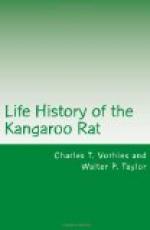HABITAT.
In the Tucson region spectabilis is typically a resident of the Lower Sonoran Zone. This is perhaps the principal zone inhabited over its entire range, but the animal is often found in the Upper Sonoran also, and in the Gallina Mountains of New Mexico Hollister found it invading the yellow pine Transition where the soil was dry and sandy and the pine woods of open character. The same observer found it common in grassy and weed-grown parks among the large junipers, pinyons, and scattering yellow pines of the Bear Spring Mountains, N. Mex. Bailey calls attention to the fact that the animal apparently does not inhabit the lower half of the Lower Sonoran Zone, as it extends neither into the Rio Grande Valley of Texas nor the Gila Valley of Arizona. In extreme western Texas it is common at the upper edge of the arid Lower Sonoran Zone, and in this region does not enter the Upper Sonoran to any extent.
In July, 1914, Goldman found this kangaroo rat common on the plain at 4,600 feet altitude, near Bonita, Graham County, Ariz., and noted a few as high as 5,000 feet altitude on the warm southwestern slopes of the Graham Mountains, near Fort Grant. Apparently spectabilis reaches its upper altitude limit in the Burro Mountains, N. Mex., where Bailey has found it sparingly on warm slopes up to 5,700 feet, and at the western base of the Sandia Mountains, east of Albuquerque, N. Mex., where dens occur at approximately 6,000 feet.
About Tucson it is undoubtedly more common in the somewhat higher portions of the Lower Sonoran Zone, above the Covillea association, than elsewhere (Pl. IV, Figs. 1 and 2). A few scattered dens are to be seen in the Covillea belt, but as one rises to altitudes of 3,500 to 4,000 feet, and the Covillea is replaced by the cat’s-claws (Acacia sp. and Mimosa sp.) and scattered mesquite (Prosopis), with the Opuntia becoming less abundant, kangaroo rat mounds come more and more in evidence. Here is to be found the principal grass growth supporting the grazing industry, and the presence of a more luxuriant grass flora is probably an important factor in the greater abundance of kangaroo rats, both spectabilis and merriami. In this generally preferred environment the desert hackberry (Celtis pallida) is one of the most conspicuous shrubs; clumps of this species are commonly accompanied by kangaroo rat mounds.
In order to ascertain whether the banner-tailed kangaroo rat has any marked preference for building its mounds under Celtis or some other particular plant, all the observable mounds were counted in a strip about 20 rods wide and approximately 4 miles long, an area of approximately 160 acres, particular note being taken of the kind of shrub under which each mound was located. Of 300 mounds in this area, 96 were under Prosopis, 95 under Acacia,




